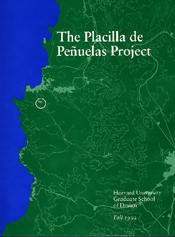The Placilla de Peñuelas Project
 One of the salient characteristics of the modern world is the apparent universality of many urban design and planning concepts. First developed in one place, usually out of a sense of practical necessity, they are often quickly transferred to other locales, often thought to be experiencing roughly the same conditions. After a while this process of invention and transference becomes, as it were, “a self-fulfilling prophecy,” particularly in these times of such fluid communications. For what one community has for a variety of sometimes almost forgotten reasons, another wants almost as a matter of course. Without us ever being fully aware of these events, the contemporary urban and suburban milieu becomes strangely familiar in various parts of the world.
One of the salient characteristics of the modern world is the apparent universality of many urban design and planning concepts. First developed in one place, usually out of a sense of practical necessity, they are often quickly transferred to other locales, often thought to be experiencing roughly the same conditions. After a while this process of invention and transference becomes, as it were, “a self-fulfilling prophecy,” particularly in these times of such fluid communications. For what one community has for a variety of sometimes almost forgotten reasons, another wants almost as a matter of course. Without us ever being fully aware of these events, the contemporary urban and suburban milieu becomes strangely familiar in various parts of the world.
On the one hand, there is absolutely nothing particularly misguided or inappropriate about this phenomenon of conceptual diffusion. In a time, for instance, of rising social expectations about dwelling environments, and of standards of living, it is both understandable and even desirable that differences between various groups’ circumstances should diminish or even disappear completely. There is a certain unalienable democracy, after all, in the sharing of such concepts.
On the other hand, when the apparent universality of urban design and planning begins to overwhelm, or worse, totally ignore otherwise vast cultural differences between one locale and another — essential differences which compose the very patchwork of human existence — then there really is a problem at hand. Unfortunately, one of the potential tragedies of modern condition is just that: the elimination of urban-architectural distinctions between places to the point where all may be comfortable but, regrettably, much the same. Nowadays, cultural awareness is a crucial ingredient in the prevalent international practice of architecture and urban design. Furthermore, the ability to step, as it were, outside of one’s own cultural sphere, even for a moment, can be a most salutary and invigorating experience. Not only is it a matter of coming to grips with the obvious foreign norms and values of the other place, but it is also an invaluable time to reflect profoundly on one’s own beliefs and common-place acceptances.
In an academic setting, design studios, such as the one illustrated here for “The Placid de Peñuelas Project” in Chile, are thus doubly valuable to an institution like the Graduate School of Design. First, they enable students to deal, first-hand, with familiar problems in otherwise unfamiliar places. Second, and as a consequence, they allow students those rare and priceless moments for self reflection which allow them to re-confirm or, indeed, disregard aspects of their own cultural condition.
To the sponsors of this design studio, Forestall Valparaiso SSA., and to all those who assisted along the way, we offer our sincere gratitude. Without their interest, generosity and hospitality, we would be greatly more impoverished.
Peter G. Rowe
Dean of the Faculty of Design
from the Foreword
Editor: Ira Tattelman,
Harvard University Graduate School of Design, 1993
X, Valparaíso, Chile
Forestall Valparaiso SSA